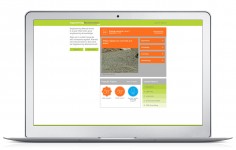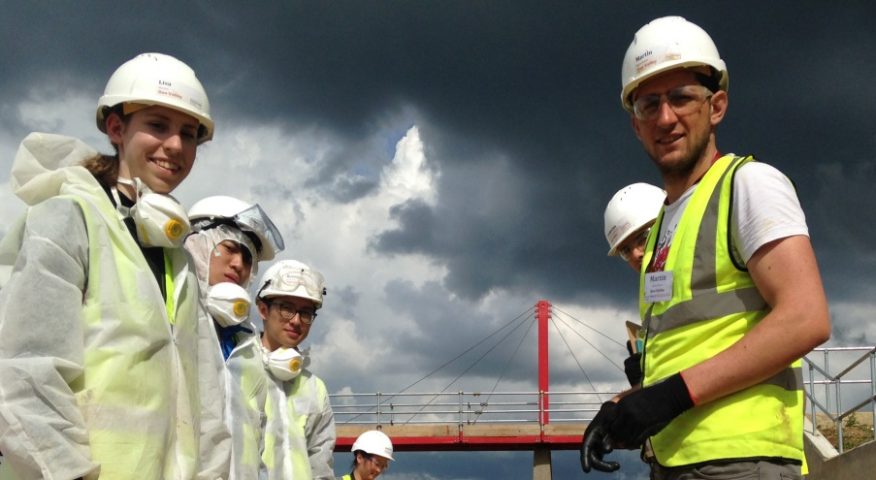In recent weeks we’ve been fortunate to have had discussions with imaginitive and ambitious organisations who are keen to transform the way construction is taught in FE colleges. Inspired by those conversations this thought piece explores how a number of Think Up Innovations could be strung together to form part of a high-impact bleneded learning for the construction sector.
Today’s construction sector needs people who are motivated and flexible workforce, that can easily develop its skills to meet demands as they arise – all of this on reduced funding. In our view, traditional face-to-face instructional teaching will always play a valuable part in delivering that training. But today, the tools exist to flip some of the learing to allow students to develop understanding of key cocepts outside the classroom so that contact time can be reserved for application of the principles in practice. As part of that contact time, we believe that highly realistic simulation of real construction sites is necessary to help learner learn their skills in context.
What follows is a series of previous or current Think Up initaitves that can help with flipping or realistic simulation.
Engineering Mastermind
 Engineering Mastermind is an online multiple-choice quiz. We developed this to help people working in the built environment sector build their general knowledge of construction. Questions are organised according to topics and categories. Each topic has three levels of difficulty. Students need to score 10/10 to pass, but they always have the opportunity to access a clue with no penalty. When they pass, they win a digital badge, which they can share online, and use to challenge other learners. To keep their badges students must create an account, which enables their scores to be logged on a leaderboard.
Engineering Mastermind is an online multiple-choice quiz. We developed this to help people working in the built environment sector build their general knowledge of construction. Questions are organised according to topics and categories. Each topic has three levels of difficulty. Students need to score 10/10 to pass, but they always have the opportunity to access a clue with no penalty. When they pass, they win a digital badge, which they can share online, and use to challenge other learners. To keep their badges students must create an account, which enables their scores to be logged on a leaderboard.
A tool like Engineering Mastermind would be ideal for helping students broaden their background knowledge of a particular topic before coming to college to learn more of the detail. Alternatively, the tool could be used to provide basic background information about a new site on which an apprentice is learning.
Bare Essentials of Concrete
The Bare Essentials of Concrete is one four Bare Essentials series that we have created to explain the principles of construction materials work to the people whose job it is to work with them on site. Of course there are lots of videos available online about concrete, but what we have attempted to create here is a set that feels ‘definitive’ and sanctioned by industry
We are currently developing proposals for creating a library of videos about site operations, available through an app. The app would use Engineering Mastermind-type questions to test understanding. For more information on this proposal see this new article.
Student Studio
Student Studio is a tool we created to manage work experience. It provides students with a five-day engineering- or construction-themed design project to work on during their week of a placement. The tool combines a VLE with a realy engaging project. Students record their work on the online interface as they work through their placement, and they can download their work, together with a certificate as evidence of their placement work.
A platform like Student Studio could be used to structure remote working for construction students, giving them the opportunity to record evidence towards their apprenticeship and for a remote supervisor to track their progress.
Eco-house
This project is an example of a project we developed to give students an experience of working with a range of construction materials. Originally created to provide a hands-on project for a construction University Technical College, the Eco House consists of a one or two-storey steel frame bolted down onto a concrete raft. This frame provides the building’s stability, alllowing the students to design and build the infill walls from a range of mateirals.
The project pack provides teachers with guidance on how to design and plan the construction of the walls in materials ranging from hempcrete and rammed earth through to pre-cast panels and timber. A contractor is then brough on board to help the students erect the steel frame and oversee the students building the walls.
Details of the eco-house project are available to download from the CITB website.
The Big Rig
The Big Rig concept is now reasonably well known. Create a 3-storey scaffolding frame, fill it with construction material and set participants a design-and-build task. The combination of hands-on activity, facilitation style and intense experience create a rich learning environment. In the first Big Rig event, students built a low-carbon shower facillity, but since then we have developed a range of other activities:
Big Rig Facade – devise and implement a strategy for refurbishing a facade for a social housing unit, recreated on the walls of a Big Rig structure
Big Rig Bridge – design and build a footbridge link between two Big Rig structures.
Big Rig Water Treatment – in this incarnation the students are challenged with creating a waste water treatment centre which will clean up water stored in a vat at the top of the Rig so that it can be discharged into a simulated water course at the bottom of the RIg.
The Big Rig is a highly flexible tool for creating a robust and realistic construction training environment. It’s frame provide the structure for what students build and at the same time allow access at multliple levels.
The Nuclear Big Rig
The Nuclear Big Rig takes the Big Rig concept to a whole new level. Two now exist, one in Bridgwater and one near Sellafield. At the latter, students are challenged with assembling, commissioning and operating a mock up of an active liquor treatment plant. As well as using the Rig to inspire students to join the nuclear industry, the facility is used extensive to run project management courses, and to introduce people with a non-technical background to the world of engineering.
The Nuclear Big Rig illustrates how a facility can be set up to simulate key activities on a construction site so that operatives can develop understanding of procedure before going on to the main site.
Constructionarium
For us, the Constructionarium offers a gold-plated experience of what is means to collaborate with people to bulid something impressive. The scale of the operation is such that the experience feels very real! While we were involved with the establishment of the Constructionarium, it is run separately from Think Up. That said, for many years we have been exploring how this model of learning could be taken on the road.
Our report ‘Constructionarium for Schools‘ looks at how a scaled-back version of Constructionarium could be developed for schools.
Our report ‘Tructionarium‘ is our report for how Constructionarium could be put in a truck and taken on the road.
